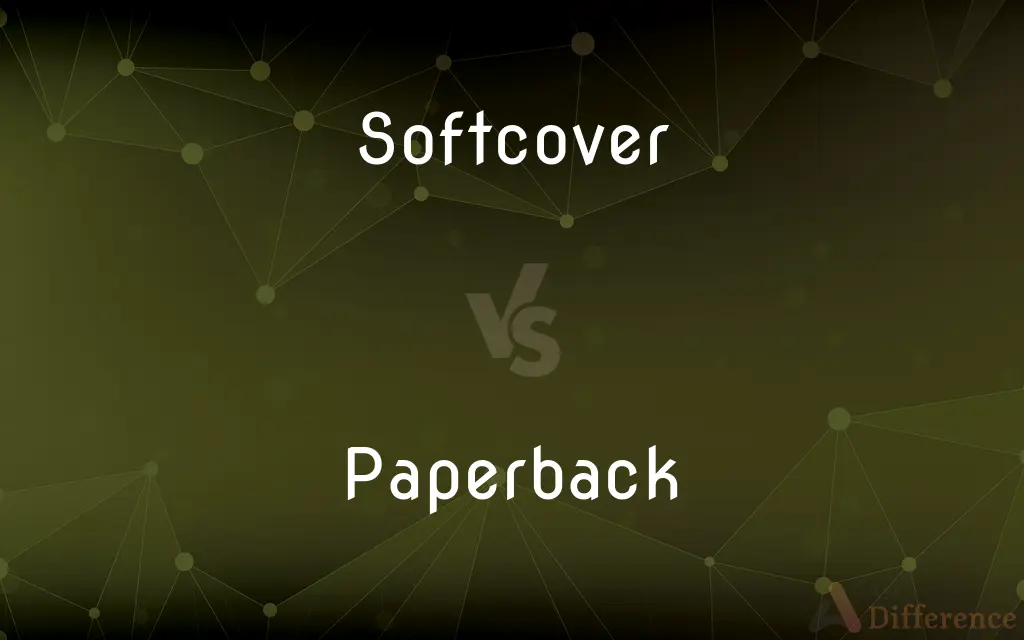Softcover vs. Paperback — What's the Difference?
Edited by Tayyaba Rehman — By Maham Liaqat — Updated on March 19, 2024
Softcover refers to books with flexible, paper-based covers, while paperback specifically denotes a type of softcover with a thick paper or paperboard cover.

Difference Between Softcover and Paperback
Table of Contents
ADVERTISEMENT
Key Differences
Softcover books encompass a wide range of books with pliable covers made of paper or other flexible materials, offering a lighter, more portable alternative to hardcover editions. Paperbacks, a subset of softcovers, are characterized by their thick paper or paperboard covers and are often used for mass-market publications due to their cost-effectiveness and portability.
While all paperbacks are softcovers, not all softcovers are paperbacks; some may be high-quality art books or journals with unique bindings and covers. Paperbacks are typically mass-produced and bound with glue, making them less durable but more affordable than other types of softcovers, which might use more resilient binding techniques.
Softcover books can vary significantly in terms of printing quality, paper type, and durability, catering to a diverse range of needs from luxury art books to everyday journals. Paperbacks, however, are generally standardized in terms of size, paper quality, and binding, designed for easy reading and transportation.
The choice between softcover and paperback often depends on the intended use and audience; softcovers offer versatility and can range from high-end publications to casual reading materials, while paperbacks are a popular choice for readers looking for convenient and affordable options for popular literature.
Comparison Chart
Cover Material
Flexible, paper-based
Thick paper or paperboard
ADVERTISEMENT
Durability
Varies widely
Generally less durable
Production
Can be high-quality or standard
Typically mass-produced
Binding
Can be glued or sewn, varies
Usually glued
Use
Broad, including art books, journals
Primarily for mass-market literature
Compare with Definitions
Softcover
Books with flexible, paper-based covers.
The artist's portfolio was published as a high-quality softcover edition.
Paperback
A type of softcover with a thick paper or paperboard cover.
The novel was released in paperback format for wider distribution.
Softcover
Can include various types of books.
The conference proceedings were made available in a softcover version.
Paperback
Mass-produced and cost-effective.
Paperback editions are often found in bookstores' bestseller sections.
Softcover
Often used for specialized publications.
Limited edition softcover art books are prized by collectors.
Paperback
Bound with glue for affordability.
The paperback's pages started to loosen with heavy use due to the glue binding.
Softcover
Varies in durability and quality.
Some softcover editions are designed for longevity with superior binding methods.
Paperback
Standardized in size and quality.
Pocket paperbacks are designed for easy transport and reading on the go.
Softcover
Can be more expensive than paperbacks.
The softcover coffee table book was priced higher due to its lavish illustrations.
Paperback
Popular for mass-market literature.
The latest mystery novel was quickly released as a paperback to meet demand.
Softcover
Not bound between hard covers
A softcover edition of a novel.
Paperback
A paperback, also known as a softcover or softback, is a type of book characterized by a thick paper or paperboard cover, and often held together with glue rather than stitches or staples. In contrast, hardcover or hardback books are bound with cardboard covered with cloth, plastic, or leather.
Softcover
A softcover book.
Paperback
A book having a flexible paper binding.
Softcover
Having covers made of paper or thin cardboard; paperback.
Paperback
A book with flexible binding.
Softcover
(publishing) A book having such covers.
Paperback
(of a book) Having flexible binding.
Paperback
To issue or publish (a book) in a paperback edition.
Paperback
A book with paper covers; - contrasted with hardback or hardcover.
Paperback
Having a flexible binding; - of books. Contrasted to hardcover or hardbacked or hardbound.
Paperback
A book with paper covers
Paperback
(of books) having a flexible binding
Common Curiosities
Why choose a paperback over a softcover?
Paperbacks are chosen for their affordability and portability, ideal for mass-market literature, while other softcovers might be selected for their quality or design.
What is a softcover book?
A softcover book features a flexible, paper-based cover and can vary in quality and durability.
What is the typical use of a paperback?
Paperbacks are commonly used for mass-market literature, such as novels and non-fiction works, due to their affordability and portability.
Are all softcovers paperbacks?
No, while all paperbacks are softcovers, not all softcovers are paperbacks; the term "softcover" encompasses a broader range of books.
Can softcovers be high-quality?
Yes, softcovers can vary from high-quality publications with durable binding and premium paper to more standard editions.
Is the content quality different in paperbacks and softcovers?
The content quality is generally the same, but the physical quality and presentation can vary significantly between paperbacks and other types of softcovers.
What makes paperbacks popular?
Paperbacks are popular for their low cost, ease of transport, and widespread availability, making them accessible to a broad audience.
What defines a paperback?
A paperback is a type of softcover book with a thick paper or paperboard cover, typically bound with glue and mass-produced.
Are paperbacks durable?
Paperbacks are generally less durable than hardcovers or high-quality softcovers due to their glue binding and paper quality.
Why are some softcovers more expensive than paperbacks?
Some softcovers are priced higher due to their premium materials, design, and production quality, particularly in the case of art books or limited editions.
Are paperbacks suitable for all types of literature?
Paperbacks are suitable for a wide range of literature, especially popular fiction and non-fiction, but may not be the best choice for high-end publications.
How are softcovers different from hardcovers?
Softcovers have flexible, paper-based covers, while hardcovers are bound with rigid, durable boards, often with a dust jacket.
How does binding affect the durability of softcover books?
The durability of softcover books can be influenced by the binding method; sewn bindings are generally more durable than glued.
Can softcover books be collectibles?
Yes, certain softcover editions, especially those with unique designs, high-quality prints, or limited runs, can be collectible items.
What are the main differences between softcover and paperback books?
The main differences lie in the cover material, durability, production methods, and typical uses, with paperbacks being a specific subset of softcovers designed for mass consumption.
Share Your Discovery

Previous Comparison
Aphorism vs. Axiom
Next Comparison
Trist vs. TrystAuthor Spotlight
Written by
Maham LiaqatEdited by
Tayyaba RehmanTayyaba Rehman is a distinguished writer, currently serving as a primary contributor to askdifference.com. As a researcher in semantics and etymology, Tayyaba's passion for the complexity of languages and their distinctions has found a perfect home on the platform. Tayyaba delves into the intricacies of language, distinguishing between commonly confused words and phrases, thereby providing clarity for readers worldwide.
















































